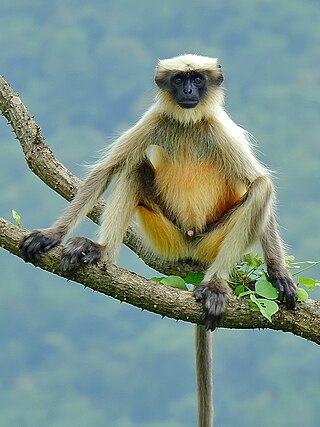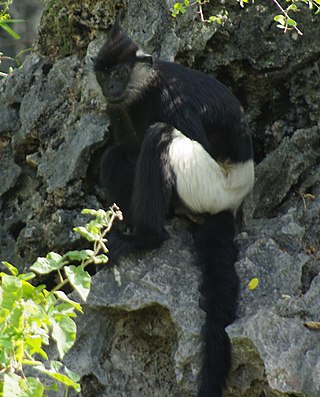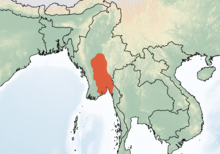
Gray langurs, also called Hanuman langurs and Hanuman monkeys, are Old World monkeys native to the Indian subcontinent constituting the genus Semnopithecus. Traditionally only one species Semnopithecus entellus was recognized, but since about 2001, additional species have been recognized. The taxonomy has been in flux, but currently eight species are recognized.

The purple-faced langur, also known as the purple-faced leaf monkey, is a species of Old World monkey that is endemic to Sri Lanka. The animal is a long-tailed arboreal species, identified by a mostly brown appearance, dark face and a very shy nature. The species was once highly prevalent, found in suburban Colombo and the "wet zone" villages, but rapid urbanization has led to a significant decrease in the population level of the monkeys. It had traditionally been classified within the lutung genus Trachypithecus but was moved to the genus Semnopithecus based on DNA evidence indicating that is it more closely related to the gray langurs.

The lutungs, langurs, or leaf monkeys are a group of Old World monkeys in the genus Trachypithecus. Their range is much of Southeast Asia.

The surilis are a group of Old World monkeys in the genus Presbytis. They live in the Thai-Malay Peninsula, on Sumatra, Borneo, Java and smaller nearby islands. Besides surili, the common names for the monkeys in the genus also often use the terms "langur" or "leaf monkey."

Gee's golden langur, also known as simply the golden langur, is an Old World monkey found in a small region of Western Assam, India and in the neighboring foothills of the Black Mountains of Bhutan. Long considered sacred by many Himalayan people, the golden langur was first brought to the attention of the Western world by the naturalist Edward Pritchard Gee in the 1950s. Adult males have a cream to golden coat with darker flanks while the females and juveniles are lighter. It has a black face and a long tail up to 50 cm (19.69 in) in length. It lives in high trees and has a herbivorous diet of fruits, leaves, seeds, buds and flowers. The average group size is eight individuals, with a ratio of several females to each adult male. It is one of the most endangered primate species of India and Bhutan.

The Nilgiri langur is a langur. This primate has glossy black fur on its body and golden brown fur on its head. It is similar in size and long-tailed like the gray langurs. Females have a white patch of fur on the inner thigh. It typically lives in troops of nine to ten monkeys. Its diet consists of fruits, shoots and leaves. The species is classified as vulnerable due to habitat destruction and poaching for its fur and flesh, the latter believed to have aphrodisiac properties.

The silvery lutung, also known as the silvered leaf monkey or the silvery langur, is an Old World monkey. It is arboreal, living in coastal, mangrove, and riverine forests in Peninsular Malaysia, Sumatra, Borneo, Java, and other nearby islands.

The East Javan langur, also known as the ebony lutung, Javan langur or Javan lutung, is an Old World monkey from the Colobinae subfamily. It is most commonly glossy black with a brownish tinge to its legs, sides, and "sideburns". It is found on the island of Java, as well as on several of the surrounding Indonesian islands. The Latin word auratus in its scientific name means "golden", and refers to a less common color variant. Note that the common name golden langur is used for a different species.

Delacour's langur or Delacour's lutung is a critically endangered species of lutung endemic to northern Vietnam. It is named for French-American ornithologist Jean Théodore Delacour.

The Cat Ba langur, also known as the golden-headed langur, is a critically endangered species of langur endemic to Cát Bà Island, Vietnam. It is among the rarest primates in the world, and possibly the rarest primate in Asia, with population size estimated at less than 70 individuals.

Phayre's leaf monkey, also known as Phayre's langur, is a species of lutung native to South Asia and Southeast Asia, namely India, Bangladesh, and Myanmar. Populations from further east are now thought to belong to other species. It is listed as Endangered on the IUCN Red List and is threatened by hunting and loss of habitat. The species epithet commemorates Arthur Purves Phayre.

The dusky leaf monkey, also known as the spectacled langur, or the spectacled leaf monkey is a species of primate in the family Cercopithecidae. It is found in Peninsular Malaysia, Myanmar and Thailand, and can occasionally be found in Singapore. During the day, these small, folivorous primates divide in sub-groups and forage for vegetation and fruit throughout the tropical forests. According to the IUCN, the dusky leaf monkey's population is declining due to habitat loss, poaching, and anthropogenic land use, which prompted the IUCN to classify the species as endangered in 2015.

Germain's langur is a lutung native to Thailand, Myanmar, Cambodia, Laos and Vietnam. The Old World monkey was previously included in Trachypithecus cristatus and Trachypithecus villosus.
The Indochinese black langur is a poorly known lutung native to Laos and adjacent Vietnam. It was originally described as a subspecies of T. auratus, but was later found to be a member of the T. francoisi group, with some maintaining it as a subspecies of that species. In 2001, it was recommended treating it as a separate species.

The Selangor silvered langur is a species of leaf monkey found on the west coast of Peninsular Malaysia. It had been previously considered a form of silvery lutung. Roos and colleagues elevated this population to a subspecies level, Trachypithecus cristatus selangorensis, in 2008. It has since come to be regarded by primatologists as a separate species, Trachypithecus selangorensis.

The West Javan langur is an Old World monkey from the Colobinae subfamily. It was formerly considered a subspecies of Trachypithecus auratus until it was elevated to a separate species by Roos and Groves. It is listed as vulnerable by the IUCN. Its range is restricted to the island of Java west of Jakarta. Its range is currently restricted to Ujung Kulon National Park, Muara Angke Wildlife Reserve and Muara Gembong due to industrial development, habitat fragmentation and the disconnection of protected areas. They are known to eat the leaves and fruits of Sonneratia in mangroves.

The Annamese langur is an Old World monkey from the Colobinae subfamily. It was formerly considered a subspecies of Trachypithecus germaini until it was elevated to a separate species by Roos and Groves in 2008. Its fur is lighter in colour than that of Trachypithecus germaini. Its range includes parts of Cambodia, Laos and Vietnam.
The Shan State langur is a subspecies of primate in the family Cercopithecidae. It is found in eastern Myanmar and southwest China. While it is typically considered a subspecies or even a synonym of Phayre's leaf monkey, it is sometimes listed as a full species.

The Indochinese grey langur is a species of lutung native to East and Southeast Asia.


















